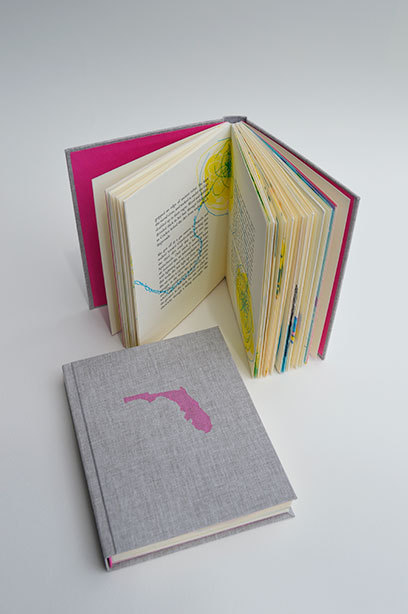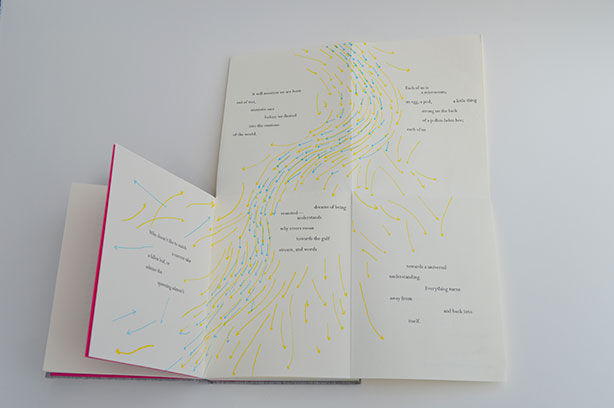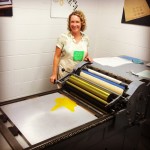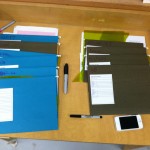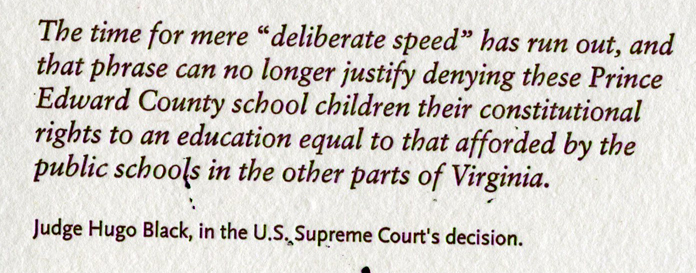Category: Projects
what endures
What Endures is the 2017 edition in the Artist’s Publication Series from Ringling College of Art and Design. The book was conceived, written, and designed by Jessica Peterson. The content was produced, printed and bound by students in the Collaboratory: Artists’ Publication class at Ringling College.
The narrative considers the history of Sarasota, Florida in the early 1820’s, when it was a haven for enslaved people who had escaped from bondage, as well as Indigenous Americans who escaped from Andrew Jackson’s Trail of Tears.
A Guide to Florida, 2016
A Guide to Florida, 2016
Letterpress printed with photopolymer plates on Mohawk Superfine. Case binding with twelve fold-outs. A collaboration between Jessica Peterson and Small Craft Advisory Press, this bookwork contains the words and designs of 12 writers and 12 book artists, including Keith Kopka and AB Gorham, Mary Jane Ryals and Denise Bookwalter, Jessie King and Allison Milham, Deborah Hall and Landon Perkins, Ron Salutsky and Abigail Lucien, Jay Snodgrass and Ellen Knudson, Jessica Plante and Jessica Peterson, Michael Trammel and Scott Bell, Kristine Snodgrass and Bridget Elmer, Danilo John Thomas and Michelle Ray, Christine Poreba and Kevin Curry, Jeff Peters and Sonja Rossow.
Read about the process under PROJECTS.
More info on the SCAP website.
Starting WPA production
I visited SCAP for a week in the summer of 2014, to start printing The Guide to Florida. Other participants came to help out with the production. It was a blast to work with some many people in the printshop, it was a real collaborative and supportive process. AB Gorham, Allison Milham and Denise Bookwalter (the staff of SCAP) are amazing and efficient administrators
Visiting the Archive
All the participants met for the first time in Tallahassee in December 2013. We curated a great mixed of mostly Florida-based writers and artists, including Scott Bell, Denise Bookwalter, Kevin Curry, Bridget Elmer, AB Gorham, Deborah Hall, Jessie King, Ellen Knudson, Keith Kopka, Abigail Lucien, Allison Milham, Landon Perkins, Jeff Peters, Jessica Peterson, Jessica Plante, Christine Poreba, Michelle Ray, Sonja Rosow, Mary Jane Ryals, Ron Salutkey, Jay Snodgrass, Kristine Snodgrass, Danilo Thomas and Michael Trammel
The first task was to pair one writer with one artist. We did this through a random drawing. Then, we visited the Florida State Archives, looked at the original manuscript, and researched our individual chapters.



Each pair was given a set of constraints to work with, and a deadline of Summer 2014.
Guidelines:
- Size: 11” x 12 ¾” (2 sections by 3 sections, each section is 5.5” x 4 ¼”)
- We will send artists an InDesign template file with size, color and font
- Font is: Perpetua: title (14pt), heading (12pt) and body text (10pt)
- Title for each chapter is on first panel of section: 2.5 inches from top of page to baseline of 14 pt text, centered on page
- 4 colors: Pantone 101 (yellow), Pantone 230 (magenta), Pantone 298 (blue), black
Kick-off: The WPA project at Florida State University
Denise Bookwalter approached me in the Fall of 2013 about working on a collaborative project with Small Craft Advisory Press. After a bit of research, I found an unpublished manuscript on the website of the Florida State Archives. The manuscript was a collection of non-fiction stories written for children in Florida by writers for the WPA. I proposed that we re-publish this manuscript, through the eyes of paired sets of artists and writers.
Here’s my original notes from the process:
PROCESS
A writer and a book artist interpret the same chapter from the WPA’s guide to Florida. The content should update/reform/critique the original text, not just illustrate it. The process of how this happens is like a game. Constraints and rules are set, and each individual develops ideas and content before merging these ideas into a single form:
- Each writer picks a chapter, and develops writing inspired by the chapter. (Ashley G, maybe you can help come up with a way to describe the length and quantity. We don’t want a whole manuscript, but maybe 3 to 4 poems, or a list of words, or a short essay).
Each book artist/printer is assigned one of the selected chapters and develops imagery and sequence (pattern, imagery and color, even structure, but using few or no words).The writer and the artist can talk about their ideas, but can’t show each other the work until both visual and textual ideas are in semi-realized form.
- Then, the mash-up happens. The writer and book artist share/show each other the ideas, there is editing and revision for both components, and a final design is developed.
- I imagine the final form of all the work as a series of pamphlets or a multi-section book of some kind, containing all seven chapters. Structural considerations, ideas and other constraints can be discussed in December?
PARTICIPANTS
A group of 7 to 10 designers/printers and 7 to 10 writers. My suggestions are below, but they are just suggestions, and I think we could have up to ten pairs.
50 years since Griffin v County School Board of Prince Edward County
May 25, 2014 is the 50th anniversary of the U.S. Supreme Court decision Griffin v County School Board of Prince Edward County, which provided a conclusion for the history I’ve been working on for The Unbound Project.
To commemorate the day, I am releasing a pdf version of Unbound. You can download the pdf here and read more about the letterpress version.
Read Professor Larissa Fergeson’s great op-ed about why this case matters: http://hamptonroads.com/2014/05/fergeson-case-opened-prince-edward-schools










